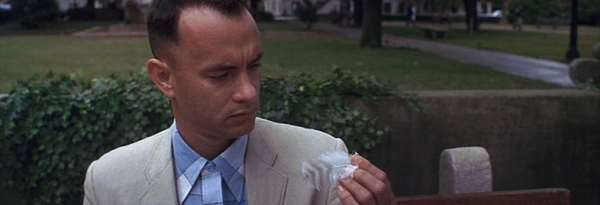Each year, the Library of Congress adds exactly 25 movies to the National Film Registry. Thousands of potential films from the entire history of cinema are evaluated for this honor. Those limited few that get chosen are determined to be “culturally, historically or aesthetically significant” works that are “selected because of their enduring significance to American culture.” These are the cream of the crop, the very pinnacle of the art form – movies that innovate, movies that inspire, movies that define who we are… Except this year, when the Registry added ‘Forrest Gump‘. That horrible sound you hear is me puking blood in disgust.
Seriously, has no one on the selection committee actually watched this putrid shitfest of a motion picture? I’ve written before about my absolute loathing for ‘Forrest Gump’. I could rant about it some more if you’d like, but I’m already giving myself an ulcer just thinking about it. To the very core of my bitter, hardened soul, I despise every hateful frame of that movie. We as a species would be better served if any trace of its existence could be purged from the historical record. Yet the Library of Congress considers it one of the most important films ever made, worthy of preservation for all eternity? Gag.
I find the inclusion of ‘The Silence of the Lambs‘ less personally offensive. It’s a good picture, if overrated. Even so, I question the need to add relatively recent and very popular movies like these to the National Film Registry. Isn’t the whole point of the Registry to preserve works that are in some danger of being lost to history? Both ‘Gump’ and ‘Lambs’ were blockbuster hits that already have the endorsement of Academy Award wins behind them. They’re both guaranteed to be treated as crown jewels by their respective studios. With only 25 spots on the Registry open per year, there simply have to be other movies more in need of the attention.
I can at least see a case for ‘El Mariachi‘. It may not be an objectively good movie. (It’s basically just cheapo exploitation claptrap.) But the film helped kick off the low-budget indie movement of the 1990s and opened the door for minority directors in Hollywood.
The complete list of this year’s additions is below. They span the range from acknowledged classics (Disney’s ‘Bambi‘ or Chaplin’s ‘The Kid’) to forgotten early works by important directors (John Ford’s ‘The Iron Horse’), long-neglected masterpieces (‘Porgy and Bess’), populist fare (George Pal’s ‘War of the Worlds’), and experimental obscurities (‘Allures’).
You would be forgiven if you’ve never heard of a lot of these movies. Honestly, I was only familiar with about half of them. You can read descriptions of them, along with arguments in their favor, in the official Library of Congress announcement. The ‘Nicholas Brothers Family Home Movies’ and the Frank Capra war documentary ‘The Negro Soldier’ sound particularly fascinating, and certainly a lot more worthy of inclusion in the Registry than ‘Forrest Gump’.
- ‘Allures’ (1961)
- ‘Bambi’ (1942)
- ‘The Big Heat’ (1953)
- ‘A Computer Animated Hand’ (1972)
- ‘Crisis: Behind a Presidential Commitment’ (1963)
- ‘The Cry of the Children’ (1912)
- ‘A Cure for Pokeritis’ (1912)
- ‘El Mariachi’ (1992)
- ‘Faces’ (1968)
- ‘Fake Fruit Factory’ (1986)
- ‘Forrest Gump’ (1994)
- ‘Growing Up Female’ (1971)
- ‘Hester Street’ (1975)
- ‘I, An Actress’ (1977)
- ‘The Iron Horse’ (1924)
- ‘The Kid’ (1921)
- ‘The Lost Weekend’ (1945)
- ‘The Negro Soldier’ (1944)
- ‘Nicholas Brothers Family Home Movies’ (1930s-1940s)
- ‘Norma Rae’ (1979)
- ‘Porgy and Bess’ (1959)
- ‘The Silence of the Lambs’ (1991)
- ‘Stand and Deliver’ (1988)
- ‘Twentieth Century’ (1934)
- ‘War of the Worlds’ (1953)
Unfortunately, while being placed in the Film Registry may grant some of these movies a little bit of attention and exposure, and guarantees that at least one copy of each will be archivally preserved in the Library of Congress, it does not necessarily assure that any of them will be released to the public on home video if they haven’t already been.
[via Some Came Running]






Aaron Peck
I can see why ‘Gump’ was included. Like it or not, it really is a quintessential American film. Anyway, I like the film so I think it’s good news. Although the inclusion of ‘Bambi’ has me very happy. Really, they should just take all 25 slots on year and archive each Disney animated classic.
Josh Zyber
AuthorWell, the explicit message of the movie (not implicit, but explicit) is that intelligence makes you evil, and we should all aspire to follow the example set by a moron with the IQ of a turnip. So, in that respect, I suppose that the film is quintessentially American. That doesn’t say much for us as a society, unfortunately. 🙁
M Enois Duarte
I agree with you Josh, for the most part — I don’t care for ‘Forrest Gump’ at all. It’s a cliched dribbling mess, purely intended to pull at the heartstrings with little challenge or reward. But at the same time, I can understand the reasoning behind the committee’s selection.
The problem is with their methodology, summarized by the vague phrase “culturally, historically or aesthetically significant.” For years, this has actually worked well because you can’t clearly define “culturally” or “aesthetically” with absolute certainty. This means, the committee has a very wide selection pool, from the completely obscure and forgotten (“The Westinghouse Works” and “The Life of a City” shorts) to the popular classics and most memorable (‘Wizard of Oz’ and ‘Gone with the Wind’).
I definitely don’t see an argument for the ‘Forrest Gump”s aesthetic quality because it has none. It’s too simple and plain. I can see a possible case for its cultural relevance, considering its portrayal of 20th Century events. But I think in the end, the movie’s inclusion is ultimately its historical value. It broke new ground in the visual effects arena and captured the imagination of the nation with a nostalgic, uncritical look at U.S. history when it released.
However, if what I suspect is true and ‘Forrest Gump’ was primarily chosen for its historical value, then I’m worried about future selections. With this kind of reasoning, they could just as well make the case for ‘Titanic’ next year or ‘Avatar’ in about 8 years.
Sean M
I don’t know if we have to worry too much, since neither of those films (which are not even close to “Gump” or “Silence” in my view) have the obvious Oscar history.
Sean M
Err. That should be “those last films” meaning ‘Titanic’ and ‘Avatar’
EM
Also, note that significant doesn’t mean “good”.
Sean M
Both Forrest Gump and Silence of the Lambs are important in Academy Award history (beyond being awarded Best Picture).
Gump was Hanks’s second straight Lead Actor award, a feat only Spencer Tracy had previously managed in 1939.
Silence was the second movie to win the “Big 5” awards, the previous one being It Happened One Night in 1935.
I’d guess these had a significant role in determining their placement as part of the historical record. I don’t really agree with their inclusion (but enjoyed both films), but I am sure this placement had a role.
Josh Zyber
AuthorIf anything, I’d think that the movies’ Oscar wins would work against their being added to the Registry. Those films have already been recognized by an official body proclaiming their importance. The Registry doing the same is just sort of redundant. There is no danger of these movies falling into obscurity, whereas history has almost completely forgotten about once-popular silent film comedies like A Cure for Pokeritis.
In the case of Porgy and Bess, that movie has been neglected and tied up in rights disputes that kept it out of the public eye for decades. Being added to the Registry is a validation of its importance. Gump and Lambs don’t need that kind of attention. Perhaps in 30-50 years, if people have largely forgotten about Silence of the Lambs at that time, then it would be appropriate to add it to the Registry. But not now. Many other films are more deserving.
EM
For me, it’s funny seeing the Nicholas Brothers on the list. I don’t recall having heard of them before last Sunday. One of my father’s Christmas presents to me was a DVD collection of Christmas episodes of various vintage TV series. One of these was from Abbott-and-Costello comedy-variety show The Colgate Comedy Hour, and the Nicholas Brothers were one of the acts. They were amazing. I thought the home movies sounded good even before I read the NFR description and became aware of the fascinating historical contexts.
Deaditelord
While I don’t share Josh’s extreme hatred for Forrest Gump (mine would be the incredibly overrated Shakespeare in Love and it’s BS best picture win over Saving Private Ryan), I would agree that Forrest Gump and The Silence of the Lambs were not the best movies released in their respective years. As far as I’m concerned, Beauty and the Beast was the best movie of 1991 and Pulp Fiction runs circles around Forrest Gump.
Ben Jennings
No, it was BS that Shakespeare in Love beat The Thin Red Line for Best Picture. It was HILARIOUS that Shakespeare in Love beat Saving Private Ryan.
Alex
That whole year was BS, if you ask me. Gwyneth Paltrow over Cate Blanchett? Honestly??!!
William Henley
You know, I guess I can finally come out. I have been hiding the fact that I HATE Forrest Gump for years. Thought there was something wrong with me, because everyone else I know seems to love it. But it goes beyond that – I HATE Tom Hanks. He only seems to be able to do one role – the far-away detached character. I can’t stand him.
The only thing Forrest Gump has going for it is that it had great music, and brought attention to child sexual abuse. No, the movie is badly written, badly acted, badly directed. Its a steaming pile of crap.
Man, did it feel good to come out and say that! Been hiding my dislike for the movie for years!
EM
With two of her films among this year’s inductees, I wonder if Sally Field believes that the National Film Preservation Board likes her, right now really likes her.
Julian
I like Forrest Gump. Sorry guys. I really do.
Shannon Nutt
First, FORREST GUMP is a great movie. Second, even if YOU don’t think it’s a great movie, you can’t deny the cultural impact that the film had – which is EXACTLY why it was chosen.
Shannon Nutt
Oh, I hate to rain on your hate-parade, but I guarantee you TITANIC will be on this list in the future. AVATAR probably not so much, but TITANIC for sure.